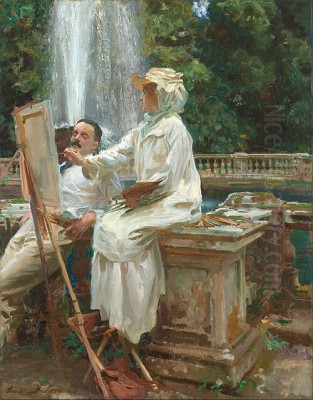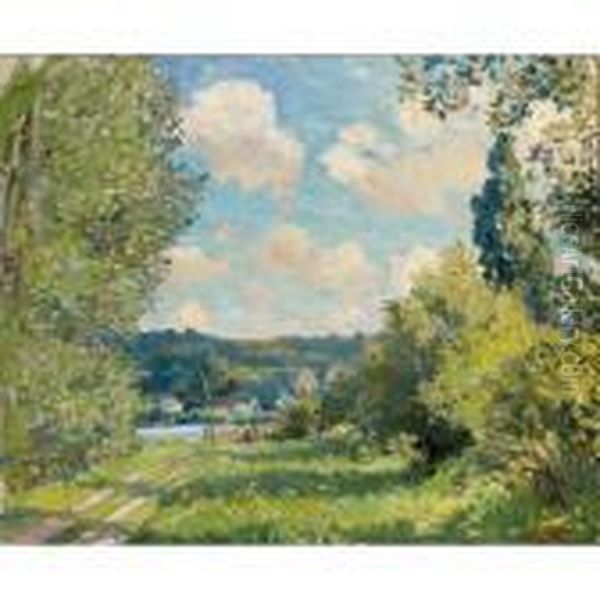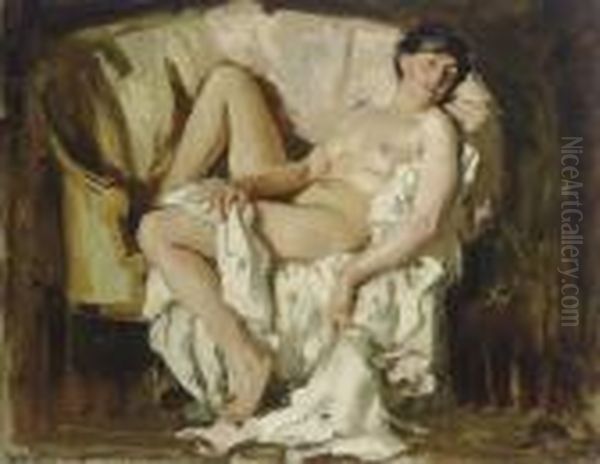
Wilfrid Gabriel de Glehn stands as a significant figure in early 20th-century British art, celebrated for his vibrant Impressionistic style that captured the interplay of light and colour in landscapes, portraits, and sun-drenched genre scenes. Born in Sydenham, London, on October 9, 1870, he navigated the transition from Victorian academicism towards a more modern, continental sensibility. His long and productive life, ending on May 11, 1951, spanned a period of immense artistic change, and his work remains a testament to a joyful engagement with the visible world, heavily influenced by his extensive travels and his close association with the leading artists of his time, most notably the expatriate American master, John Singer Sargent.
His parentage reflected a blend of cultures; his father, Alexander de Glehn, was of Baltic German descent (naturalised British), and his mother, Louise Creighton, was French. This cosmopolitan background perhaps prefigured his later ease in moving between artistic circles in Britain, France, and America. His artistic inclinations were nurtured early on, leading him towards a formal education that would shape his technical skills and aesthetic outlook.
Early Life and Artistic Formation
De Glehn's formal art training began after his initial schooling at Brighton College. He enrolled at the South Kensington School of Art (which later evolved into the Royal College of Art), a key institution in London for design and fine art education. Seeking further refinement and exposure to continental trends, he moved to Paris, the undisputed centre of the art world at the time. There, he studied at the prestigious École des Beaux-Arts, immersing himself in the rigorous academic training offered.
In Paris, he had the privilege of studying under respected masters such as Gustave Moreau and Élie Delaunay. Moreau, known for his Symbolist works and as a teacher to future Fauves like Henri Matisse and Georges Rouault, provided a rich, imaginative counterpoint to purely academic instruction. Delaunay represented a more traditional, classical approach to figure painting and portraiture. This combination of influences provided de Glehn with a solid foundation in drawing and composition, while the artistic ferment of Paris exposed him to the revolutionary ideas of Impressionism and Post-Impressionism.

Crucially, it was during his time in Paris that de Glehn forged a lifelong friendship with John Singer Sargent. Sargent, already an established figure, recognised the younger artist's talent. This connection proved immensely influential, both personally and professionally. They shared a similar artistic sensibility, a love for travel, and a fascination with capturing the effects of light en plein air. This friendship would lead to significant collaborations and shared artistic journeys in the years to come.
Collaboration and Early Career
The association with Sargent quickly bore fruit. Between 1890 and 1893, de Glehn assisted Sargent, along with Edwin Austin Abbey, on the ambitious mural project for the Boston Public Library. This major commission, depicting themes from the history of religion, was a significant undertaking that required considerable skill in large-scale composition and execution. Working alongside Sargent and Abbey on such a prestigious project provided invaluable experience and exposure for the young de Glehn.
Following this period, de Glehn began establishing his own reputation. He started exhibiting his work, initially showing promise as a painter adept at capturing likenesses and atmospheric effects. His style began to absorb the lessons of French Impressionism, particularly the work of artists like Claude Monet and Pierre-Auguste Renoir, focusing on broken brushwork, a brighter palette, and the depiction of fleeting moments and light conditions. He travelled frequently, finding subjects in the landscapes and cityscapes of Europe.
His talent gained recognition within the British art establishment. In 1900, he was elected a member of the New English Art Club (NEAC). The NEAC was a vital exhibiting society founded in opposition to the perceived conservatism of the Royal Academy, attracting artists influenced by French Impressionism and Post-Impressionism, such as Philip Wilson Steer and Walter Sickert. Membership placed de Glehn firmly within the progressive wing of British art at the turn of the century.
Marriage and Artistic Partnership
A significant development in de Glehn's personal and artistic life occurred in 1904 (some sources suggest 1903, but 1904 is more commonly cited) when he married Jane Erin Emmet in New Rochelle, New York. Jane was an accomplished American artist in her own right, hailing from a prominent family with strong artistic connections – her sisters included the portraitists Lydia Field Emmet and Rosina Emmet Sherwood, and her cousin was Ellen Emmet Rand. Jane became not only his wife but also a frequent model and painting companion.

Their marriage marked the beginning of an enduring personal and artistic partnership. Wilfrid and Jane de Glehn often travelled and painted together, setting up their easels side-by-side in picturesque locations across Europe and America. Jane frequently appears in Wilfrid's paintings, often depicted reading, sketching, or simply enjoying the sunlight in gardens or landscapes. These works possess a particular intimacy and charm, reflecting their shared life and artistic pursuits.
Jane's own artistic career continued alongside her husband's, and they occasionally exhibited together. Her presence undoubtedly enriched de Glehn's life and work, providing companionship on their extensive travels and a readily available, sympathetic model whose likeness he captured with affection and skill in numerous canvases. Their shared passion for art and travel defined much of their life together.
The Impressionist Influence and Style
Wilfrid de Glehn is primarily categorised as a British Impressionist. While he received academic training, his mature style owes a significant debt to the French Impressionists. He embraced the practice of painting outdoors (en plein air) to directly capture the transient effects of sunlight and atmosphere. His brushwork became looser and more visible, applying dabs and strokes of often unmixed colour that would blend in the viewer's eye. This technique allowed him to convey the vibrancy and immediacy of the scenes before him.
His palette brightened considerably compared to traditional British painting, favouring luminous blues, greens, pinks, and yellows to depict sunlit gardens, sparkling water, and warm southern landscapes. He was particularly adept at rendering the play of light and shadow, whether dappling through leaves, reflecting off water surfaces, or illuminating figures. Some critics noted an affinity with Renoir in his treatment of figures bathed in sunlight and his generally optimistic, sensuous approach to painting, occasionally leading to the informal description of him as the "British Renoir."
However, de Glehn's work was not merely derivative. He integrated Impressionist techniques with his strong grounding in drawing and composition. His portraits, while often informal and painted with Impressionistic freedom, retain a sense of structure and psychological insight. His landscapes, though focused on light and atmosphere, are underpinned by careful observation and compositional design. He navigated a path that absorbed modern French influences without entirely abandoning traditional British sensibilities, creating a style that was both contemporary and accessible. His contemporaries in Britain exploring similar avenues included artists associated with the NEAC like Henry Tonks and Ambrose McEvoy.
A Life of Travel and Painting

Travel was fundamental to de Glehn's art. Throughout his career, he journeyed extensively, seeking out locations renowned for their light, colour, and picturesque qualities. Italy was a frequent destination, particularly Venice, where he, like Sargent and countless artists before him, was captivated by the unique interplay of water, light, and architecture. His Venetian scenes often focus on canals, lagoons, and sunlit squares, rendered with fluid brushwork and a keen eye for reflection. Florence and Rome also provided rich subject matter.
France remained a constant source of inspiration, from the Normandy coast to the sunnier climes of the south. Greece, especially the island of Corfu, offered brilliant Mediterranean light and classical associations, resulting in some of his most luminous and idyllic paintings, often featuring Jane. Spain, Portugal, and later, trips to the United States (particularly New England, reflecting his wife's origins) further broadened his repertoire of landscapes and genre scenes.
These travels were not mere holidays; they were working expeditions. The de Glehns would often spend months abroad, immersing themselves in the local environment and producing numerous sketches and finished paintings. This constant movement and exposure to different environments kept his work fresh and vibrant, continually providing new motifs and challenges in capturing diverse light conditions and landscapes. His sketchbooks and canvases became a visual diary of a life spent in pursuit of light.
The War Years and Official Recognition
The outbreak of the First World War interrupted de Glehn's established pattern of travel and painting. Initially, he and Jane volunteered with the British Red Cross in France. Reflecting the anti-German sentiment prevalent in Britain during the war, and despite his family having been British for generations, he anglicised his name by dropping the 'von' (though sources vary on whether his family ever formally used 'von', the change to 'de Glehn' simplified it and distanced it from Germanic associations).
Later in the war, his artistic skills were officially employed. He served as an interpreter with the Royal Garrison Artillery and was subsequently commissioned as an Official War Artist. In this capacity, he was sent to the Italian front in 1917. His wartime paintings depict scenes of military life, landscapes marked by conflict, and portraits of personnel, rendered with the same sensitivity to light and atmosphere but often imbued with a more sombre tone appropriate to the subject matter.
After the war, de Glehn resumed his career with renewed vigour. His reputation continued to grow, leading to further recognition from the art establishment. Having been a member of the NEAC since 1900, he was elected an Associate of the Royal Academy (ARA) in 1923, and became a full Royal Academician (RA) in 1932. He also became a member of the Royal Society of Portrait Painters (RP), acknowledging his skill in that genre. These memberships solidified his position as a respected figure within the mainstream of British art.
Mature Style and Notable Works
In the post-war decades, de Glehn continued to produce a prolific body of work, maintaining the Impressionistic style he had honed over the years. His subjects remained largely consistent: sunlit landscapes from his travels, elegant portraits, and intimate garden scenes, often painted at the Manor House in Stratford Tony, Wiltshire, which he and Jane acquired later in life. His handling of paint remained fluid and confident, characterised by a love for vibrant colour and dynamic light effects.
Among his many works, certain subjects and specific paintings stand out. His depictions of Venice, such as The Lagoon, Venice, capture the shimmering atmosphere of the city with characteristic brio. French scenes like Vieux port sur la Seine (dated 1906 in some records) showcase his ability to render bustling river life with Impressionistic immediacy. His paintings from Corfu are particularly noted for their brilliant Mediterranean light.
His portraiture remained an important aspect of his output. He painted portraits of friends, family, and commissioned subjects, often placing them in informal, naturally lit settings. His numerous portraits of his wife, Jane, are among his most personal and appealing works, charting their life together through art. While a specific Portrait of Clare Collins is mentioned in some contexts, details and dating can be elusive without reference to specific collections. Other notable works include paintings like The Fountain, Villa Torlonia, Frascati (c. 1909) and various depictions of English gardens and landscapes, contrasting with his more exotic locales. He painted fellow artists, including studies of Sargent.
Exhibitions and Reputation
Throughout his long career, Wilfrid de Glehn was a regular exhibitor at major London venues. He showed frequently at the Royal Academy summer exhibitions, the New English Art Club, the Leicester Galleries (a prominent London gallery known for showing modern British and French art), and the Goupil Gallery. His work was also seen internationally, including exhibitions in Paris (at galleries like Durand-Ruel, famous for promoting the French Impressionists) and in the United States (at Knoedler & Co. in New York, and later retrospective attention from galleries like Spanierman Gallery).
His participation in these exhibitions placed his work alongside that of leading contemporaries, both British and international. In Britain, he exhibited alongside fellow NEAC members like Steer, Sickert, and Tonks, as well as RA stalwarts like Sir William Orpen and Augustus John (who was associated with both groups). His connection to Sargent ensured his visibility in circles that appreciated cosmopolitan, technically accomplished painting influenced by Impressionism.
De Glehn achieved considerable success and recognition during his lifetime. His paintings were popular with collectors for their attractive subjects, technical facility, and cheerful sensibility. While perhaps not considered as revolutionary as some of his French Impressionist predecessors like Monet or Degas, or as stylistically radical as Post-Impressionists like Paul Cézanne or Fauves like Matisse, de Glehn carved out a distinct and respected place within the landscape of British art. He represented a successful adaptation of Impressionist principles to a British context, admired for his craftsmanship and his ability to capture beauty in the everyday world.
Later Life and Legacy
Wilfrid de Glehn spent his later years primarily based in England, residing with Jane at The Manor House in Stratford Tony, Wiltshire. The house and its gardens provided ample subject matter close to home, although he likely continued to travel when possible. He remained active as a painter well into his later life, continuing to exhibit his work. He passed away on May 11, 1951, at the age of 80, leaving behind a substantial oeuvre that documents a life dedicated to art and the pursuit of light.
His legacy rests on his position as one of Britain's foremost Impressionist painters. He successfully absorbed the lessons of French modernism, particularly the focus on light, colour, and plein air painting, adapting them into a personal style that retained strong draughtsmanship and compositional sense. His close friendship and professional association with John Singer Sargent were defining features of his career, linking him directly to one of the giants of the era.
His numerous paintings of sun-drenched landscapes, elegant portraits, and intimate genre scenes continue to be admired for their technical skill, vibrant palettes, and optimistic spirit. They offer a window into the cosmopolitan world he inhabited, capturing the beauty of locations from Venice and Corfu to English gardens and New England shores. Alongside his wife Jane, he exemplified a life devoted to artistic partnership and shared exploration. Wilfrid de Glehn's work remains a significant contribution to British art of the early twentieth century, celebrated for its enduring visual appeal and its masterful handling of light and colour.
Conclusion
Wilfrid Gabriel de Glehn's artistic journey took him from the academies of London and Paris to the sunlit landscapes of Southern Europe and beyond. As a key figure in British Impressionism, he skillfully blended continental techniques with his own sensibilities, creating works characterized by vibrant colour, dynamic brushwork, and a profound sensitivity to the effects of light. His long association with John Singer Sargent, his fruitful partnership with his wife Jane Emmet de Glehn, and his extensive travels all shaped a rich and varied body of work. Though perhaps overshadowed at times by more radical modernists, de Glehn's paintings endure, admired for their technical brilliance, their joyful celebration of the visible world, and their significant place within the narrative of British art's engagement with modernity. His work continues to charm and engage viewers with its luminous depiction of life.